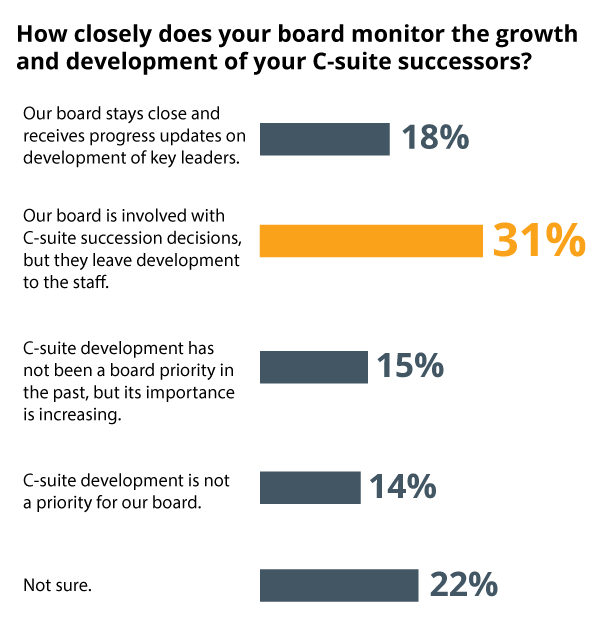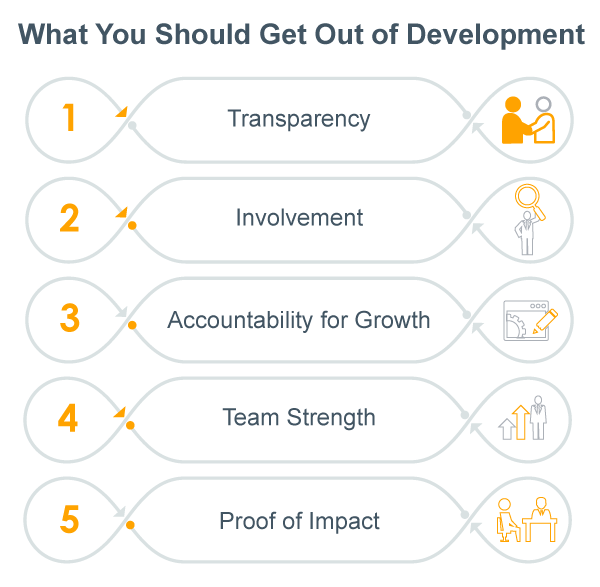“We recognize that CEO succession is a top priority, but how involved should we be with C-suite leadership development?”
It’s a surprisingly fraught question for many board members, and I hear it often. Sometimes they ask me quietly, after expressing private concern that one or more executives aren’t cutting it. Other times they ask in a board meeting after a review of C-suite performance or readiness for a particular business opportunity.
Broadly speaking, shareholders are demanding that boards play a larger role in talent management and culture. They’re being held more accountable for making sure the skills and capabilities of the company’s workforce meet the needs of its business strategy.

But when it comes to C-suite leadership development specifically, just how involved is the board supposed to be? The reality is that boards are all over the place. In a webinar on this topic, I asked a group of HR executives and board members how involved their boards are in C-suite leaders’ development.
Only about 18% said their board stays close to development for C-level executives. Yet another 31% said their board cared only about succession decisions but left development to others. About half said their board had little to no involvement, or if they did, it wasn’t visible.
These numbers align with what we’re seeing in our clients and boardrooms. Directors know they need to be more deeply involved in development but don’t know how. At what point do they become too involved? Under growing pressure to ensure strong leadership in the C-suite and beyond, how should the board set the right expectations?
The Most Critical Mistakes Boards Make in C-Suite Leadership Development
As the data showed, you’re in good company if your board is grappling with their role in C-suite leadership development. In our work, we’ve seen boards and CHROs wrestle through five common mistakes.
Mistake #1: Foggy Lens Succession
Flawed thinking: Naming a successor is enough.
Traditionally, boards assume their only obligation is to identify the next chief executive officer. And while that may satisfy the regulatory requirements, fewer and fewer regard that approach as sufficient.
There’s a deeper obligation to planning for true business continuity.
An energy sector client of ours had recently pulled off a tremendous business turnaround and was aiming its attention to CEO succession. With a strong CEO at the helm, and a recent winning streak, the board basically handed things over to the CEO.
But as the board confronted pressing disruption threats and the growing need to transform the culture to run in step with a new business model, several board members raised questions about the background and capabilities of the current CEO and the whole C-suite team.
Questions soon emerged about entrepreneurial skills, external networking with legislative and regulatory bodies, innovation, and leading enterprise-wide change. While the CEO maintained a confident stance, the board became increasingly concerned that their current succession plan may be too shortsighted.
They asked the CEO to expand the succession plan and become more transparent about what exactly was being done to develop senior executives. Initially puzzled, the CEO soon saw how critical it was to look beyond replacement for his own role.
Eventually, they ended up doing a full audit of the senior team’s capabilities. They then targeted development not only in light of CEO succession, but to develop skills across the whole team that would support emerging business challenges.
Since then, the CEO has successfully moved on and has been capably replaced by a strong successor, while a series of other player moves were made to ensure team strength under the new CEO. As one board member put it, “We learned a lot that we didn’t know by getting closer to executive development, and our team is stronger for it now.”

Mistake #2. Readiness Roulette
Flawed thinking: Job requirements will force an executive to develop key skills.
“Well, he’s just going to have to get better at it, or he’s not going to make it in this job!”
This kind of thinking crops up on many C-suite development plans. The logic goes that a smart executive will naturally develop a skill if the pressures of a role require it.
Can it happen? Sure. But it’s a gamble. We’ve often seen leaders put into a role with some known development areas. Then some months down the road, they’re struggling with the same issue, only now with much more severe consequences.
In one large retail company, this happened across an entire senior team. The company had recently acquired another retailer and suddenly became a very different organization. They were much bigger, more cross-functional, and had executives in roles across both organizations. The acquired CEO was also looking to retire soon, which placed urgency on a succession plan for that new business.
They assessed the senior team and confirmed several strong players for critical new roles. But one development area showed up again and again: The executives (from both organizations) tended to work in silos, an issue exacerbated by the merger.
The board’s reaction? The environment is going to force everyone to get better in this area. Let’s let things play out.
But it turned out to be a game of roulette. A few executives improved, but most others continued their territorial approach. As a result, the company stumbled, and progress slowed dramatically.
Soon, the board stepped in to regroup. They needed a more structured development approach. We worked with their executives to create group development focused on cross-functional integration and networking. In addition, executives worked with coaches to build structured involvement, networking, and integration plans to accelerate alignment.
While the company was soon back on track, the CHRO and board saw in hindsight that things could have been different. They’d gambled on the assumption that the situation would force development. And they’d lost.
Mistake #3. Back-of-a-Napkin Development
Flawed thinking: A great CEO can develop great C-suite executives with no formal plan needed.
“I’ve got the game plan right here in my head.” I’ve heard this more times than I can count. There’s often a feeling among C-suite leaders that they have risen to a level beyond the need for formal development. In fact, I have literally seen a CEO explain their succession plan to me on the back of a napkin, because it wasn’t written down anywhere else.
This informal approach is particularly common in the wake of success. In a global high-tech manufacturer where the CEO was a superstar, the board felt an obligation to start planning early for the CEO’s succession, but were worried that replacing him would be impossible.
With a strong internal candidate leading their largest business, they created a president role so he could work closely alongside the current CEO. Meanwhile, the CEO had no explicit plan for the president’s development. He simply wanted to give him plenty of opportunities to take time to observe and learn.
But after a few short months, the president felt stalled and conflicted about his role. As an incredibly effective leader himself, he suddenly had few accountabilities separate from the CEO. Effectively, he was a “CEO in waiting.” Not only was he frustrated, but his influence with the senior team was eroding, as there was little he could accomplish without the CEO’s involvement.
The board became concerned. They asked the CEO for clarity on the plan and progress of the president’s development. Initially, the CEO chafed, feeling he had this covered in a more private process. But eventually, he came around to the board’s request for more transparency.
As a result, we began working with the CEO and president to design a more intentional approach to development. A simple experience map helped the board see where the president’s development stood in specific areas, what they were focusing on, and concrete evidence of how his development was progressing.
For board members, it was uncomfortable to press their stellar CEO on the issue. But as the conversation about the president’s growth became more specific, dialog sparked increased ideation and involvement. New experiences and learning opportunities were added to the CEO’s plan, and the president’s growth hastened. The board chair now regards the president as “ready when we are."

Mistake #4. Backroom Skill Building
Flawed thinking: Executive coaching works best in private.
It’s not uncommon for the board to know that a C-suite member has a weakness, but no one internally can serve as an appropriate coach. So they turn to an external coach to help.
But while an executive coach can be valuable, it’s dangerous to expect private miracles.
I worked with a chief commercial officer (CCO) who had all the ingredients to be extraordinary. His one drawback was that he tended to be too self-reliant and didn’t leverage his team. When things got tough, he tended to take it on himself while his team’s capability plateaued.
The board asked the CEO to coach him, but the CEO felt the situation was too complex and rooted in psychology. So an outside coach was hired to work with the CCO privately. After several months, little was changing.
Why? Because while coaching conversations can be private, the impact of coaching must be observed in the open. In this instance, the coach worked only with the CCO, almost entirely without the engagement of other stakeholders. The CCO needed to prove that he could better leverage and grow his people, and he needed to prove it to them. The coach couldn’t help the CCO accomplish that without working more closely with the CCO’s stakeholders.

Specifically, the coaching plan needs three elements:
- Specific accountabilities for the successor to meet in the coaching engagement
- Measures of progress in the executive’s environment
- A clear role for the CEO in the development process
With greater transparency, this CCO could adopt a “stickier” development plan. The new plan showed him and others more demonstrable progress and freed him up to leverage his diverse talents.
Mistake #5. Holding Out for a Hero
Flawed thinking: A strong CEO ensures a strong senior team.
We see this routinely: Boards assume their involvement in development extends only to CEO successors. But even with the best CEO, it’s a mistake not to have transparency about full C-suite development.
This was the case with a health system. Eager to replace a CEO who resigned suddenly, the board was highly involved in an urgent search for the next CEO. In the meantime, as issues became evident with other members of the C-suite, the board adopted a common refrain: “When our new CEO gets in, his/her first priority will be to take care of the senior team.”
Not an uncommon or entirely unfounded point of view. However, when the new CEO arrived, the board disengaged entirely from C-suite development. With no discussion on the topic, the new CEO mistakenly concluded that the board would react negatively to overly hasty moves with his new team. For nine months, he refrained from making any player or structural changes.
Months later, both sides were frustrated. The board was impatient, puzzled at why the CEO was so slow to act. Meanwhile, the CEO felt handcuffed under the incorrect assumption that he should not yet shuffle the team.
This quickly gave way to no small amount of venting and open dialog (including a postmortem on board-to-CEO dynamics). We quickly set to work with the CEO and board to create a complete team mosaic, using objective data to map the team’s strengths, gaps, and performance assurance plan. In a matter of weeks, a new structure was established on the senior team, roles were shifted and realigned, and the team was set on a new course.

What Should the Board Demand Out of C-Suite Leadership Development?
With these common mistakes in mind, let’s return to one of the earlier questions: What should the board expect when it comes to C-suite leadership development?
At heart, there are five things every board needs:
- Transparency and Clarity: Which leaders are we targeting for accelerated growth? Why? Why not? What do we seek to achieve by developing our senior executives? And what, exactly, is each leader seeking to grow, and how will their progress be demonstrated?
- Involvement: At a minimum, boards must be brought into conversations about development, the progress achieved, and how they can help. I have yet to see a situation regarded as too much board involvement. Rather, it’s the absence of discussion that causes problems. After all, the wisdom and experience of board members is the principal reason for their membership. Lack of involvement misses the opportunity to capitalize on that asset.
- Accountability for Growth: Board members must share responsibility and accountability for overseeing C-suite growth and ensuring it meets its purpose. Growth for its own sake may or may not benefit the enterprise.
- Team Strength: The board is responsible for looking beyond the CEO to the entire C-suite. How a senior team evolves and grows with a changing business and culture is a topic that lives in close proximity to CEO succession decisions. Today’s boards must maintain a strong understanding of the strength and growth of the senior team mosaic.
- Proof of Impact: In keeping with the board’s oversight role, there must be evidence that executives are making the progress that the business needs. It’s not enough to just say, “We’re working on communication or influence.” Expectations should include concrete examples of how that is happening.
Make C-Suite Leadership Development Intentional
On the journey to readiness, the biggest mistake is to think you’ve arrived. No CEO or other C-suite executive is ever finished developing. The healthiest, most resilient leaders are always preparing for the next challenge. Nothing has proven that more than the pandemic.
Several times lately, I’ve been asked how the pandemic has changed the need for certain executive capabilities. While there are broad themes, the more relevant truth is that it looks a bit different in every organization. Among our clients, the ones faring best are the ones where their boards have taken steps (years earlier) to draw attention to C-suite development and create stronger, more agile senior teams.
But this thinking isn’t limited to crisis. It’s also about opportunity. I’ve sat in board discussions about thrilling new ventures and commercial possibilities. Directors, with furrowed brows, wonder if their team has the capability to go after it. It’s in these moments when C-suite development plays a crucial role, because the conversation goes beyond “who we have” on the senior team. Boards are able to examine “where we’re going” and have better evidence to anticipate how senior teams might respond when faced with a new challenge. In the world of risk mitigation, this is valuable currency.
For all these reasons, boards need to make C-suite leadership development a top priority, not eventually, but right away. There won’t be time to adjust when the next crisis or opportunity comes knocking.
For more on what boards need to know about C-suite succession and development, check out our webinar series for boards of directors: What Your Board Needs to Know About C-Suite Leadership Development.
Matt Paese, Ph.D., is senior vice president, Succession Management and C-Suite Services at DDI. He leads DDI’s Executive Services group, where he and his team help CEOs, boards, senior teams, and executives enhance leadership to grow business, cultural, and personal success.
Topics covered in this blog

